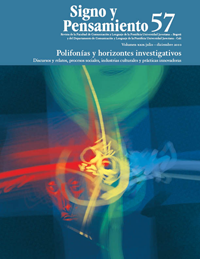Abstract
This article presents the results of research work whose main aim was to test a set of rules iconographicaly represented via educational signs in order to motivate coexistence practices among citizens in public spaces in Chapinero, Bogotá. The inquiry, set within the framework of urban pedagogy, would like to contribute to the discussion around the possibility of resorting to communicative strategies vis-à-vis citizen education, particularly through the creative use of the dynamics of language.
Burbano, A. y Páramo, P. (2008, julio-octubre), “El aprendizaje por reglas y la convivencia ciudadana en el espacio público”, Pretil, año 6, núm. 18, Universidad Piloto de Colombia, pp. 62-72.
Colom, A. (1990), “La pedagogía urbana, marco conceptual de la ciudad educadora”, en La ciudad educadora. I Congreso Internacional de Ciudades Educadoras, Barcelona, Ajuntament de Barcelona, pp. 115-128.
Costa, J. (1987), Señalética, Barcelona, Enciclopedia del Diseño. Centro Internacional de Inves- tigación y Aplicaciones de la Comunicación.
Eco, U. (2000), Tratado de semiótica original, Barcelona, Lumen.
Glenn, S. S. (1988), “Contingencies and Metacon- tingencies: Toward a Synthesis of Behavior Analysis and Cultural Materialism”, The Beahavior Analysis, núm. 11, pp. 161-179.
Klinkenberg, J.-M. (2006), Manual de semiótica general, Bogotá, Fundación Universitaria Jorge Tadeo Lozano.
Mockus, A. (2003), “Cultura ciudadana y comunicación”, en Revista La Tadeo, Fundación Universitaria Jorge Tadeo Lozano, núm. 68, pp. 106-111.
Páramo, P. (2009, marzo-junio), “Meta-contingencias y cambio de prácticas culturales en el espacio público urbano”, en Pre-Til, Año 7, núm. 20, Instituto de Investigación y Proyectos Especiales, Universidad Piloto de Colombia.
— (2010), “Pedagogía urbana: elementos para su delimitación como campo de conocimiento”, en Revista Colombiana de Educación, núm. 57, Universidad Pedagógica Nacional, pp. 14-27.
Páramo, P. y Cuervo, M. (2006), Historia social situada en el espacio público de Bogotá desde su fundación hasta el siglo xix, Bogotá, Ediciones Universidad Pedagógica Nacional.
Rodríguez Diéguez, J. L. (1977), Las funciones de la imagen en la enseñanza: semántica y didáctica, Barcelona, G. Gili, Colección de Comunicación Visual.
Salcedo, M. A. y Caicedo, S. (2007, julio- diciembre), “Señales visuales urbanas en algunos cruces viales de Cali, Colombia”, en Revista Científica Guillermo de Ockhan, vol. 5, núm. 2, pp. 11-133.
Santos, C. y Lobo, N. (2003), Psicología del aprendizaje, Bogotá, Universidad Santo Tomás.
Trilla, J. (1993, mayo), “La educación y la ciudad”, en Educación y ciudad, núm. 2, Bogotá, Instituto para la Investigación Educativa y el Desarrollo Pedagógico (IDEP), pp. 6-19.
Urrego, Y. (2008), “Observación conductual”, en Páramo, P., Técnicas de recolección de información, Bogotá, Universidad Piloto de Colombia.
This journal is registered under a Creative Commons Attribution 4.0 International Public License. Thus, this work may be reproduced, distributed, and publicly shared in digital format, as long as the names of the authors and Pontificia Universidad Javeriana are acknowledged. Others are allowed to quote, adapt, transform, auto-archive, republish, and create based on this material, for any purpose (even commercial ones), provided the authorship is duly acknowledged, a link to the original work is provided, and it is specified if changes have been made. Pontificia Universidad Javeriana does not hold the rights of published works and the authors are solely responsible for the contents of their works; they keep the moral, intellectual, privacy, and publicity rights.
Approving the intervention of the work (review, copy-editing, translation, layout) and the following outreach, are granted through an use license and not through an assignment of rights. This means the journal and Pontificia Universidad Javeriana cannot be held responsible for any ethical malpractice by the authors. As a consequence of the protection granted by the use license, the journal is not required to publish recantations or modify information already published, unless the errata stems from the editorial management process. Publishing contents in this journal does not generate royalties for contributors.


